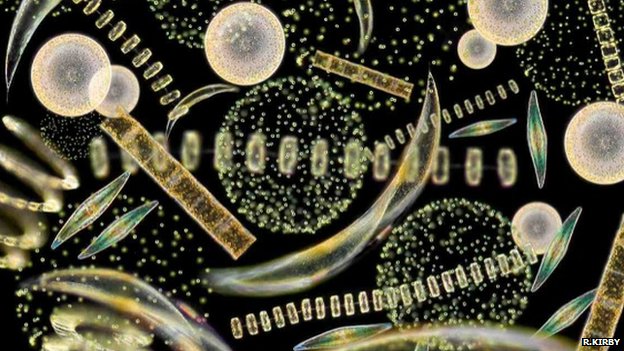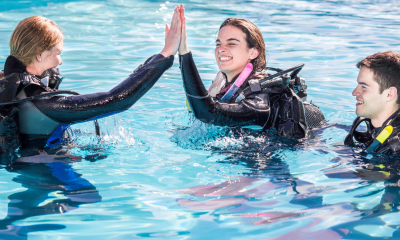Marine Life & Conservation
App Set To Match The Oceans’ Plankton

A study is calling on the world’s sailors to help map the oceans’ phytoplankton, microscopic plants that form the bedrock of marine food chains.
Researchers have developed an app for people to submit readings from Secchi disks – a method used since 1865.
The team hopes the data will help them understand what is happening beneath the waves.
They have been “astonished” by the response so far but are hoping for more readings from the southern hemisphere.
“The reason the project came about was because, in 2010, some Canadian scientists wrote a paper that suggested that the phytoplankton in the world’s oceans had declined by 40% since the 1950s,” explained project leader Richard Kirby, a research fellow at Plymouth University’s Marine Institute.
“If true, this is a dramatic decline. As phytoplankton starts the food chain, they dictate the productivity at every level above,” he observed.
“Ultimately, phytoplankton determines the amount of fish in the sea and the number of polar bears on the ice.”
Marine biologists have been using the Secchi disk method to measure the abundance of phytoplankton for 150 years.
The white disk measures 30cm (1ft) in diameter and is lowered into the water on the end of a tape measure. When it is no longer visible from the surface, the reading – known as the Secchi depth – is recorded.
“It is a very robust method and not prone to error and it is a good measure of phytoplankton abundance,” said Dr Kirby.
“Away from estuaries and more than a kilometre from the coast, the main influence on water clarity is phytoplankton.”
He explained how he had the idea of setting up a citizen science project: “It occurred to me sat at my desk that while there are a lot of scientists, there are not that many that are marine scientists, and fewer still that go to sea.
“And the ones that do go to sea do not go out very far. If they do go out far, they rarely go back to the same place.
“I thought that there are an awful lot of sailors out there; day sailors, cruising sailors. Many of these sailors will sail the same waters and take the same route time and time again.”
Dr Kirby, and colleagues Drs Nicholas Outram and Nigel Barlow from the University’s School of Computing and Mathematics, developed the Secchi Disk App that would store a reading while at sea before uploading it to a database once the smartphone was back within range of a mobile phone network.
“We can now collect Secchi depth measurements from all over the world’s oceans and add that to the data from the 1860s to make a continuous – with a slight dip – record to see what is happening to the phytoplankton in the oceans,” he said.
The database, managed by Dr Sam Lavender, is accessible, free-of-charge, from the project’s website.
The reason for collecting measurements via the Secchi method, Dr Kirby explained, was because the Canadian team’s findings proved to be quite controversial among scientists.
“Some said that they did not see any similar decline, while others said they saw an increase rather than a decline,” he said.
The study was criticised because it combined Secchi disk measurements with data gathered using modern technology that became available to scientists in the late 20th Century.
Despite the criticism, the authors have defended their findings, saying the dramatic decline was a result of sea surface temperature.
“They said that the warming had increased stratification so fewer nutrients were reaching the oceans’ surface, and so there was less phytoplankton growth,” Dr Kirby said.
He added that in the waters around UK shores, observations showed that phytoplankton were appearing at different times of the year.
He said that changes in the seas’ seasons had potential consequences for life beneath the waves.
“This is changing the coupling in the marine ecosystem. Evolutionarily, everything is synchronised – just as it is on land.
“When the timings start altering, even by just a fraction, then things no longer work through the food chain.”
To help raise awareness of the vital role phytoplankton plays in marine and terrestrial food chains, Dr Kirby has written and produced a short film called Ocean Drifters, which has been sent to every secondary school in England.
Narrated by Sir David Attenborough, the film also explains how plankton is responsible for the familiar smell of “sea air”, and how the tiny organisms are involved in the formation of clouds.
Source: www.bbc.co.uk/news
Photo: Richard Kirby
Blogs
Invitation from The Ocean Cleanup for San Francisco port call

6 years ago, The Ocean Cleanup set sail for the Great Pacific Garbage Patch with one goal: to develop the technology to be able to relegate the patch to the history books. On 6 September 2024, The Ocean Cleanup fleet returns to San Francisco bringing with it System 03 to announce the next phase of the cleanup of the Great Pacific Garbage Patch and to offer you a chance to view our cleanup system up-close and personal.
We look forward to seeing you there.
To confirm your presence, please RSVP to press@theoceancleanup.com
PROGRAM
Join The Ocean Cleanup as our two iconic ships and the extraction System 03 return to San Francisco, 6 years and over 100 extractions after we set sail, to create and validate the technology needed to rid the oceans of plastic.
Our founder and CEO, Boyan Slat, will announce the next steps for the cleanup of the Great Pacific Garbage Patch. Giving you a chance to view our cleanup system and the plastic extracted.
Hear important news on what’s next in the mission of The Ocean Cleanup as it seeks to make its mission of ridding the world’s oceans of plastic an achievable and realistic goal.
Interviews and vessel tours are available on request.
PRACTICALITIES
Date: September 6, 2024
Press conference: 12 pm (noon)
Location: The Exploratorium (Google Maps)
Pier 15 (Embarcadero at Green Street), San Francisco, CA
Parking: Visit The Exploratorium’s website for details.
RSVP: press@theoceancleanup.com
Video & photo material from several viewing spots around the bay
We look forward to seeing you there!
ABOUT THE OCEAN CLEANUP
The Ocean Cleanup is an international non-profit that develops and scales technologies to rid the world’s oceans of plastic. They aim to achieve this goal through a dual strategy: intercepting in rivers to stop the flow and cleaning up what has already accumulated in the ocean. For the latter, The Ocean Cleanup develops and deploys large-scale systems to efficiently concentrate the plastic for periodic removal. This plastic is tracked and traced to certify claims of origin when recycling it into new products. To curb the tide via rivers, The Ocean Cleanup has developed Interceptor™ Solutions to halt and extract riverine plastic before it reaches the ocean. As of June 2024, the non-profit has collected over 12 million kilograms (26.4 million pounds) of plastic from aquatic ecosystems around the world. Founded in 2013 by Boyan Slat, The Ocean Cleanup now employs a broadly multi-disciplined team of approximately 140. The foundation is headquartered in Rotterdam, the Netherlands, and opened its first regional office in Kuala Lumpur, Malaysia, in 2023.
Find out more about The Ocean Cleanup at www.theoceancleanup.com.
Marine Life & Conservation
SHARK MONTH ARRIVES AT ROYAL WILLIAM YARD, PLYMOUTH

A shark has been spotted approaching Royal William Yard in Plymouth, much to the surprise of swimmers, paddleboarders and onlookers.
With its distinctive dorsal fin cutting through the water, the sizeable shark swam along the coastline, before turning to head inland towards Firestone Arch at Royal William Yard. The appearance drew a crowd, who were captivated for more than an hour by the unusual sight – and it was all caught on video.
The shark is one of many expected sightings at Royal William Yard over the coming weeks… because today marks the start of Shark Month!
In reality, the ‘shark’ spotted along the Plymouth shoreline was actually a custom-made model, created by the team at Royal William Yard and sailed underwater by Caroline Robertson‑Brown from the Shark Trust, who donned scuba diving gear for the occasion.
The stunt took place to launch Shark Month in style and draw attention to the work of the leading international conservation charity, which is based in Britain’s Ocean City. Spectators were reassured that the water was safe and many entered into the spirit of the performance, swimming or sailing alongside the shark.
Shark Month will take place across Royal William Yard throughout July and will feature an extravaganza of art, entertainment and advocacy for everyone to enjoy. The packed programme of events starts with an art exhibition and ends with a trip on paddleboards with shark experts – with everything from a shark quiz to a Jaws screening in between.
Paul Cox, CEO of the Shark Trust, said: “There are often assumptions and misconceptions when it comes to sharks. This was certainly the case with the shark spotted at Royal William Yard! While the British coastline is home to many species of shark, this was not one of them. However, we’re thrilled it caught people’s attention, because seeing a shark is a special and memorable moment. That is precisely why we want to celebrate these incredible creatures, highlight the need for conservation, and ask for help to safeguard their future.”
For more information about Shark Month at Royal William Yard, visit the Shark Trust Website.
Images and video: Jay Stone
-

 Blogs2 months ago
Blogs2 months agoDiving With… Nico, Ocean Earth Travels, Indonesia
-

 News1 month ago
News1 month agoMurex Bangka Announce New Oceanfront Cottages & Beachfront Dining
-

 Blogs2 months ago
Blogs2 months agoA new idea in freediving from RAID
-

 Marine Life & Conservation1 month ago
Marine Life & Conservation1 month agoIceland issue millionaire whale hunter a licence to murder 128 vulnerable fin whales
-

 Marine Life & Conservation2 months ago
Marine Life & Conservation2 months agoThe Shark Trust Great Shark Snapshot is back
-

 News3 months ago
News3 months agoCharting New Waters; NovoScuba Goes Global with the Launch of their Revolutionary Dive Training Agency!
-

 Gear News1 month ago
Gear News1 month agoNew Suunto Ocean – a dive computer and GPS sports watch in one for adventures below and above the surface
-

 Marine Life & Conservation Blogs2 months ago
Marine Life & Conservation Blogs2 months agoBook Review: Plankton
















